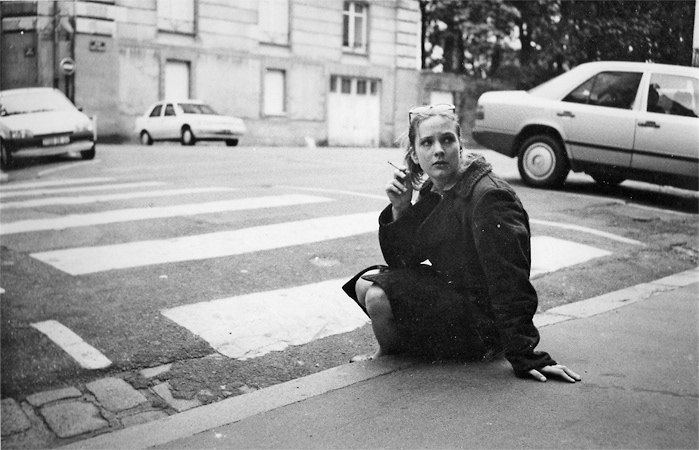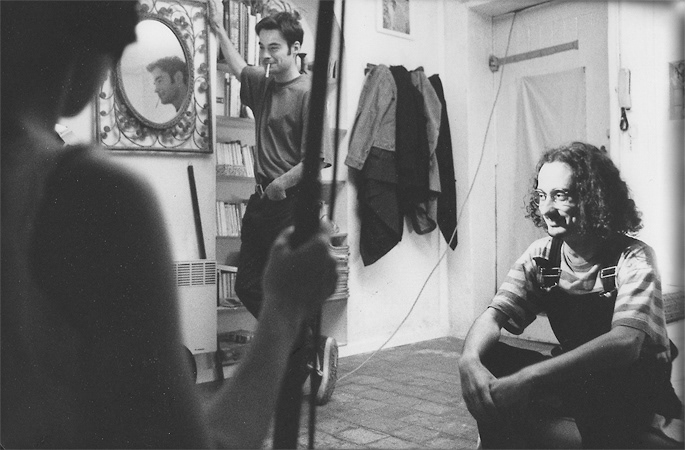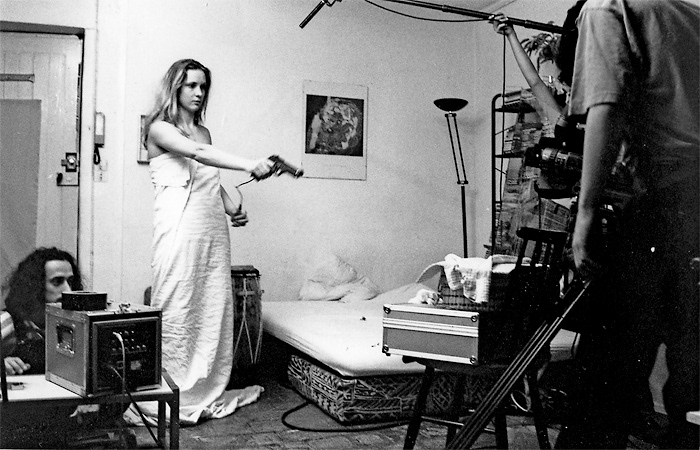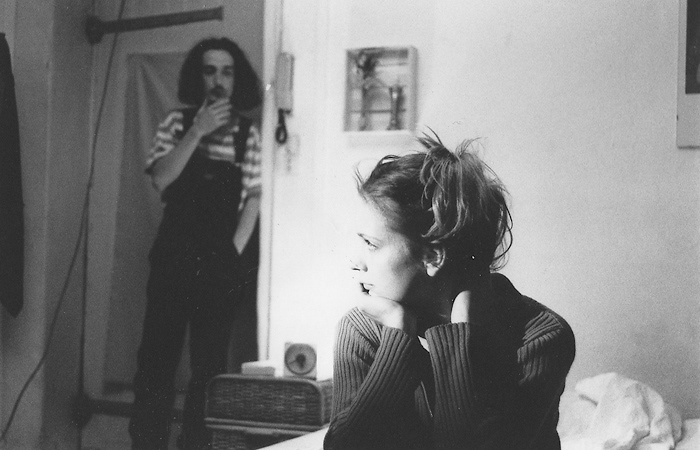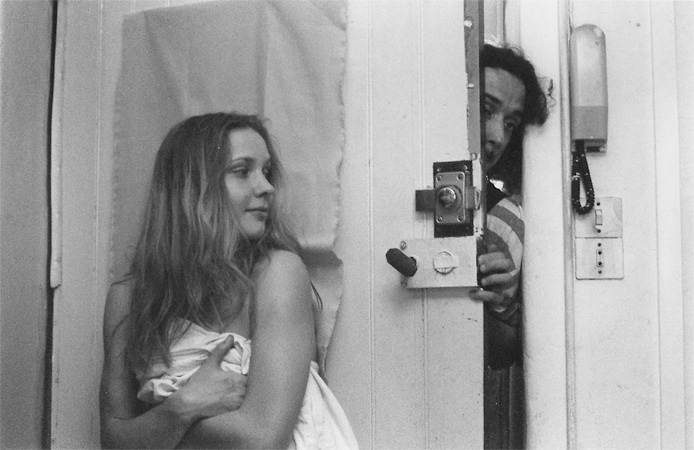Brome : Vika
Vidéo-clip, Hi8, 2018.
Extrait du EP «Le Bonheur» (Sosei records).
Filmé au début des années 2000, à Vyborg, Kingisepp, Veymarn, Moscou et Saint Pétersbourg (Russie).
Brome : Vika
Video-clip, Hi8, 2018.
Extract from brome's 'le bonheur' EP (Sosei records).
Filmed in the early 2000s. Images from Vyborg, Kingisepp, Veymarn, Moscou and St Petersburg (Russia).
Extract from brome's 'le bonheur' EP (Sosei records).
Filmed in the early 2000s. Images from Vyborg, Kingisepp, Veymarn, Moscou and St Petersburg (Russia).
Savel : Rire Ensemble
(XIII bis Records)
Clip vidéo, Hi8, 2000.
Tourné à Nantes, en Bretagne sud.
(XIII bis Records)
Clip vidéo, Hi8, 2000.
Tourné à Nantes, en Bretagne sud.
Savel : Laughing together
XIII bis Records
Video clip, Hi8, 2000.
Shoot in the region of Nantes, south of Bretagne.
XIII bis Records
Video clip, Hi8, 2000.
Shoot in the region of Nantes, south of Bretagne.
Savel : Ma Madone
Clip vidéo, bonus de l'album "Terminal" (Les Disques en Chantier Records, 2008). DV, 2005.
Tourné à Nantes, Bretagne sud. Avec Sarah Reyjasse et Yann Savel.
Clip vidéo, bonus de l'album "Terminal" (Les Disques en Chantier Records, 2008). DV, 2005.
Tourné à Nantes, Bretagne sud. Avec Sarah Reyjasse et Yann Savel.
Savel : My madonna
Video clip, bonus of the album "Terminal" (Les Disques en Chantier Records, 2008). DV, 2005.
Shoot in Nantes, south of Bretagne. With Sarah Reyjasse and Yann Savel.
Video clip, bonus of the album "Terminal" (Les Disques en Chantier Records, 2008). DV, 2005.
Shoot in Nantes, south of Bretagne. With Sarah Reyjasse and Yann Savel.
C'est plutôt les filles que je regarde dans les films
Court-métrage, master DV, 12', 2002.
Avec Nat' O., Stef' R. & Kochka # Scénario & dialogue
Gild Gábor, d'après Gérôme "Norburt" G. & Pat Gábor.
«Je veux bien faire ce que tu veux, mais il faut que tout soit bien préparé. Ne rien faire à la légère. Alors décide : si je dois m'asseoir, rester debout, parler ou ne rien dire. Il n'est pas question d'improviser. Si tu veux que je parle, tu me dis ce que j'ai à dire. Je dis ce que tu veux, ce qui t'arrange, je récite. N'attend pas de moi autre chose.»
Jean Eustache : "La maman et la putain" (1973).
C'est plutôt les filles que je regarde dans les films est une expérimentation théâtrale filmée.
Les deux comédiennes ne sont pas professionnelles, et n'ont même jamais joué ou monté sur une scène.
Le texte n'est en aucun cas improvisé, mais, au contraire, scrupuleusement appris. Le dialogue est lui-même la retranscription très exacte d'extraits d'une conversation entre deux garçons.
Influencé par les écrits du sociologue américain Ervin Goffman, le travail ne s'est fait que sur les intentions des personnages, à travers des indications sur les prises de pouvoir au sein de la discussion.
Court-métrage, master DV, 12', 2002.
Avec Nat' O., Stef' R. & Kochka # Scénario & dialogue
Gild Gábor, d'après Gérôme "Norburt" G. & Pat Gábor.
«Je veux bien faire ce que tu veux, mais il faut que tout soit bien préparé. Ne rien faire à la légère. Alors décide : si je dois m'asseoir, rester debout, parler ou ne rien dire. Il n'est pas question d'improviser. Si tu veux que je parle, tu me dis ce que j'ai à dire. Je dis ce que tu veux, ce qui t'arrange, je récite. N'attend pas de moi autre chose.»
Jean Eustache : "La maman et la putain" (1973).
C'est plutôt les filles que je regarde dans les films est une expérimentation théâtrale filmée.
Les deux comédiennes ne sont pas professionnelles, et n'ont même jamais joué ou monté sur une scène.
Le texte n'est en aucun cas improvisé, mais, au contraire, scrupuleusement appris. Le dialogue est lui-même la retranscription très exacte d'extraits d'une conversation entre deux garçons.
Influencé par les écrits du sociologue américain Ervin Goffman, le travail ne s'est fait que sur les intentions des personnages, à travers des indications sur les prises de pouvoir au sein de la discussion.
It is rather the girls
That I look in movies
Short film, master DV, 12', 2002.
With Nat' O., Stef' R. & Kochka # screen play & dialogue : Gild Gábor, based on Gérôme "Norburt" G. & Pat Gábor.
"I am willing to make what you want, but everything should be prepared well. Nothing lightly. So, you have to decide : If I have to sit down, remain standing, speak or say nothing. There is no question of improvising. If you want me to talk, tell me what I have to say. I only say what you want me to, I say what suit you, I recite. You won't expect anything else from me.
Jean Eustache : "The mother and the whore" (1973).
That I look in movies
Short film, master DV, 12', 2002.
With Nat' O., Stef' R. & Kochka # screen play & dialogue : Gild Gábor, based on Gérôme "Norburt" G. & Pat Gábor.
"I am willing to make what you want, but everything should be prepared well. Nothing lightly. So, you have to decide : If I have to sit down, remain standing, speak or say nothing. There is no question of improvising. If you want me to talk, tell me what I have to say. I only say what you want me to, I say what suit you, I recite. You won't expect anything else from me.
Jean Eustache : "The mother and the whore" (1973).
It is rather the girls that I look in movies is a theatrical experimental film.
Both comediennes are not professionals, and they have not even played on a stage.
The text is absolutely not improvised, but, on the contrary, scrupulously learnt. The dialogue is itself the very exact retranscription of extracts of a conversation between two boys.
Influenced by the books of the American sociologist Ervin Goffman, The work was made only on the intentions of the characters, through indications about the seizures of power in the discussion.
Both comediennes are not professionals, and they have not even played on a stage.
The text is absolutely not improvised, but, on the contrary, scrupulously learnt. The dialogue is itself the very exact retranscription of extracts of a conversation between two boys.
Influenced by the books of the American sociologist Ervin Goffman, The work was made only on the intentions of the characters, through indications about the seizures of power in the discussion.
Savel : Le collimateur
Clip vidéo, Hi8, 1998. Tourné à Nantes, Bretagne sud.
Avec :
Yann Savel : chant, guitare
Gérôme Guibert : basse
Bertrand Philippot : violon.
Clip vidéo, Hi8, 1998. Tourné à Nantes, Bretagne sud.
Avec :
Yann Savel : chant, guitare
Gérôme Guibert : basse
Bertrand Philippot : violon.
Savel : the collimator
video-clip, Hi8, 1998.
Shoot in Nantes, south of Bretagne.
With :
Yann Savel : vocal, guitare
Gérôme Guibert : bass
Bertrand Philippot : violin.
video-clip, Hi8, 1998.
Shoot in Nantes, south of Bretagne.
With :
Yann Savel : vocal, guitare
Gérôme Guibert : bass
Bertrand Philippot : violin.
Rien n'a ordinairement l'air plus vrai que le faux
Court-métrage, master Beta, 28'.
Co-production Le Théâtre Chymique - PELMEL.
Avec Alice M.-D., Lùças et Gild # D'après Temporairement épuisé d'Hubert Colas (Acte Sud-papier, 1988) # Musique originale : Savel # Chef-opérateur : V. Melcion.
Film d'étude très antérieur à mes travaux récents. On y trouve cependant déjà beaucoup de mes centres d'intérêts actuels.
Rien n'a ordinairement l'air plus vrai que le faux, adapté d'une pièce de l'auteur contemporain Hubert Colas, est un film d'étude conçu en relation avec un travail théorique sur les rapports entre théâtre et cinéma.
Il s'attache à questionner l'illusoire transparence de l'esthétique classique du cinéma, que ce soit celle du "jeu imitatif" ou celle d'une caméra invisible et omnisciente. La présence affirmée de la caméra, l'interaction entre différents niveaux de narration (notamment la musique et l'image), ainsi que les jeux volontairement décalés et dissemblables des acteurs et une attention particulière portée au travail sur le texte, produisent un effet de distanciation qui n'occulte pas les traces de l'élaboration du film, mais les met au contraire en avant de manière explicite.
Par ailleurs, le film s'inscrit également dans la contestation du "syndrôme de Casablanca" tel que le définit Peter Greenaway, c'est-à-dire "l'obligation d'avoir un début, un milieu et une fin. D'ordonner le monde, en fait, pour donner au spectateur une solution logique, imparable, unique", caractéristique de la majeure partie du cinéma narratif. La forme fragmentée que le récit adopte ici, mêlant des niveaux de "réalité" distincts, traduit la complexité des trois personnages et la confusion de leurs sentiments, autant qu'il laisse au spectateur la liberté d'interpréter l'histoire comme il l'entend.
Pat & Gild Gábor
Court-métrage, master Beta, 28'.
Co-production Le Théâtre Chymique - PELMEL.
Avec Alice M.-D., Lùças et Gild # D'après Temporairement épuisé d'Hubert Colas (Acte Sud-papier, 1988) # Musique originale : Savel # Chef-opérateur : V. Melcion.
Film d'étude très antérieur à mes travaux récents. On y trouve cependant déjà beaucoup de mes centres d'intérêts actuels.
Rien n'a ordinairement l'air plus vrai que le faux, adapté d'une pièce de l'auteur contemporain Hubert Colas, est un film d'étude conçu en relation avec un travail théorique sur les rapports entre théâtre et cinéma.
Il s'attache à questionner l'illusoire transparence de l'esthétique classique du cinéma, que ce soit celle du "jeu imitatif" ou celle d'une caméra invisible et omnisciente. La présence affirmée de la caméra, l'interaction entre différents niveaux de narration (notamment la musique et l'image), ainsi que les jeux volontairement décalés et dissemblables des acteurs et une attention particulière portée au travail sur le texte, produisent un effet de distanciation qui n'occulte pas les traces de l'élaboration du film, mais les met au contraire en avant de manière explicite.
Par ailleurs, le film s'inscrit également dans la contestation du "syndrôme de Casablanca" tel que le définit Peter Greenaway, c'est-à-dire "l'obligation d'avoir un début, un milieu et une fin. D'ordonner le monde, en fait, pour donner au spectateur une solution logique, imparable, unique", caractéristique de la majeure partie du cinéma narratif. La forme fragmentée que le récit adopte ici, mêlant des niveaux de "réalité" distincts, traduit la complexité des trois personnages et la confusion de leurs sentiments, autant qu'il laisse au spectateur la liberté d'interpréter l'histoire comme il l'entend.
Pat & Gild Gábor
Nothing seems to be more true that the false
short film, master video Beta, 28'.
Coproduction Le Théâtre Chymique - PELMEL.
With Alice M.-D., Lùças and Gild # based on Hubert Colas' play "Temporairement épuisé" (Acte Sud-papier, 1988) # Original music : Savel # Director of cinematography : V. Melcion.
Nothing seems to be more true that the false is an old work. However you already find there many of my centers of current interests.
It's a studying movie conceived in connection with a theoretical work about the relation between theater and cinema.
It questions the illusionary transparency of the classic esthetics classic film, the one of the "imitative play " or the one of an invisible and omniscient camera.
The strongly assertive presence of the camera, the interaction between different narrative levels (for exemple, between images and music), the dissimilar acting, A particular attention concerning the work of the text, produce an effect of distance which does not hide the marks of the elaboration of the movie.
Otherwise, the movie also joins in the contesting of the " Casablanca's syndrome" characterised by Peter Greenaway, That is the obligation to have a beginning, a middle and a end.
Pat & Gild Gábor
short film, master video Beta, 28'.
Coproduction Le Théâtre Chymique - PELMEL.
With Alice M.-D., Lùças and Gild # based on Hubert Colas' play "Temporairement épuisé" (Acte Sud-papier, 1988) # Original music : Savel # Director of cinematography : V. Melcion.
Nothing seems to be more true that the false is an old work. However you already find there many of my centers of current interests.
It's a studying movie conceived in connection with a theoretical work about the relation between theater and cinema.
It questions the illusionary transparency of the classic esthetics classic film, the one of the "imitative play " or the one of an invisible and omniscient camera.
The strongly assertive presence of the camera, the interaction between different narrative levels (for exemple, between images and music), the dissimilar acting, A particular attention concerning the work of the text, produce an effect of distance which does not hide the marks of the elaboration of the movie.
Otherwise, the movie also joins in the contesting of the " Casablanca's syndrome" characterised by Peter Greenaway, That is the obligation to have a beginning, a middle and a end.
Pat & Gild Gábor
